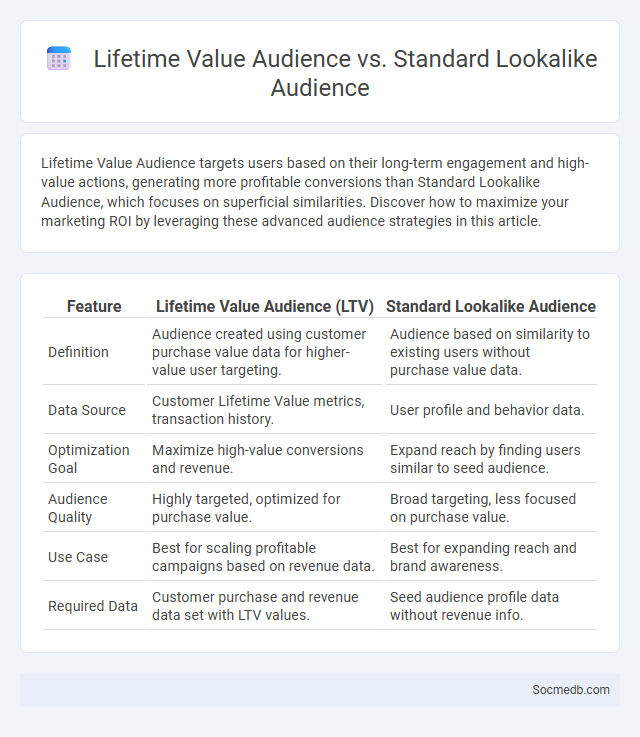
Photo illustration: Lifetime Value Audience vs Standard Lookalike Audience
Lifetime Value Audience targets users based on their long-term engagement and high-value actions, generating more profitable conversions than Standard Lookalike Audience, which focuses on superficial similarities. Discover how to maximize your marketing ROI by leveraging these advanced audience strategies in this article.
Table of Comparison
| Feature | Lifetime Value Audience (LTV) | Standard Lookalike Audience |
|---|---|---|
| Definition | Audience created using customer purchase value data for higher-value user targeting. | Audience based on similarity to existing users without purchase value data. |
| Data Source | Customer Lifetime Value metrics, transaction history. | User profile and behavior data. |
| Optimization Goal | Maximize high-value conversions and revenue. | Expand reach by finding users similar to seed audience. |
| Audience Quality | Highly targeted, optimized for purchase value. | Broad targeting, less focused on purchase value. |
| Use Case | Best for scaling profitable campaigns based on revenue data. | Best for expanding reach and brand awareness. |
| Required Data | Customer purchase and revenue data set with LTV values. | Seed audience profile data without revenue info. |
Introduction to Audience Types in Digital Marketing
Understanding audience types in digital marketing is essential for crafting targeted social media strategies that drive engagement and conversions. Your ability to identify segments like demographics, interests, and online behavior enables personalization of content and ads that resonate with specific groups. Leveraging tools such as analytics platforms helps optimize campaigns by reaching the right audience at the right time.
What is Lifetime Value (LTV) Audience?
Lifetime Value (LTV) Audience in social media refers to a group of users identified based on their long-term value to a brand, focusing on those who are likely to generate the highest revenue over time. This audience segmentation uses data analytics to predict customer behavior, purchase frequency, and engagement levels, enabling targeted marketing campaigns that maximize return on investment. Brands leverage LTV Audiences to optimize ad spend by prioritizing users with the greatest potential for retention and repeat business.
Understanding Standard Lookalike Audience
Understanding Standard Lookalike Audience in social media marketing involves identifying new users who share similar behaviors and characteristics with your existing high-value customers. This advanced targeting method leverages Facebook's algorithm to analyze source audience data and find potential customers most likely to engage or convert. Implementing Standard Lookalike Audiences enhances ad efficiency, reduces cost per acquisition, and drives scalable growth by reaching broader yet relevant audiences.
Defining Target Audience: Basics and Importance
Defining your target audience is essential for effective social media marketing because it helps tailor content that resonates with specific demographics, interests, and behaviors, increasing engagement and conversion rates. Understanding key factors like age, location, preferences, and online habits allows your message to reach the right people at the right time. Your social media strategy becomes more efficient and measurable when you clearly identify who your target audience is.
Key Differences Between LTV Audience vs Lookalike Audience
LTV (Lifetime Value) Audience targeting leverages customer purchase history and value data to identify high-value users, optimizing ad spend towards audiences with proven profitability. Lookalike Audience targeting uses machine learning to find new users who share similar demographics, interests, and behaviors with an existing seed audience, expanding reach to potential customers with comparable traits. The primary difference lies in LTV's focus on past revenue metrics, whereas Lookalike relies on similarity patterns to scale acquisition efforts.
Pros and Cons of Each Audience Type
Social media platforms attract diverse audience types, each with unique pros and cons impacting engagement and content strategy. Influencers often offer high engagement and brand trust but require consistent content and face scrutiny over authenticity. Casual users provide broad reach and varied interaction but may have lower loyalty and limited brand memory. Niche community members bring focused, highly engaged audiences ideal for targeted marketing, though growth can be slower and content must be highly relevant. Understanding these dynamics helps optimize social media campaigns for maximum resonance and ROI.
When to Use LTV Audience in Campaigns
Using a Lifetime Value (LTV) audience in social media campaigns is most effective when targeting high-value customers for retention and upselling purposes. LTV audiences enable advertisers to focus on users with the highest predicted long-term profitability, optimizing ad spend and increasing return on investment. Campaigns aimed at product launches or special offers benefit from LTV targeting by reaching loyal customers more likely to engage and convert repeatedly.
Use Cases for Standard Lookalike Audiences
Standard Lookalike Audiences on social media platforms enable advertisers to reach new users similar to their existing customers, enhancing campaign targeting accuracy. These use cases include expanding reach for product launches, increasing app installs by targeting users resembling high-value app users, and boosting e-commerce sales by finding prospects with purchase behaviors akin to loyal customers. Leveraging comprehensive user data, such as demographics, interests, and online behaviors, Standard Lookalike Audiences drive efficient budget allocation and improve return on ad spend (ROAS).
Best Practices for Target Audience Segmentation
Effective target audience segmentation on social media involves analyzing demographic data, user behavior, and interests to create tailored content that resonates with specific groups. Utilizing platform analytics tools like Facebook Audience Insights and Instagram Analytics enhances the accuracy of segment identification and campaign performance tracking. Precision in segmentation drives higher engagement rates, improves conversion metrics, and maximizes return on ad spend.
Choosing the Right Audience Strategy for Maximum ROI
Selecting the right audience strategy on social media significantly boosts your ROI by targeting precise demographics, interests, and behaviors aligned with your business goals. Utilizing data-driven tools like Facebook Audience Insights or LinkedIn Analytics helps refine your audience segments to ensure your ads reach the most responsive users. Tailoring content and ad campaigns to these specialized groups enhances engagement and conversion rates, maximizing the effectiveness of your marketing budget.
 socmedb.com
socmedb.com